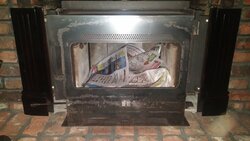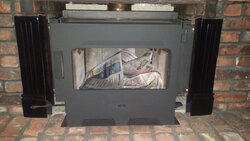I'm in my 8th year with my Hampton HI-300 insert. Since the initial install I've slowly upgraded my installation based on stuff I've learned on Hearth.com.
2010: Insulated the firebox a little (I was being very cautious back then)
2012: Insulated the firebox the rest of the way. Adjusted the door latch.
2014: Plugged the auxiliary air hole (although, in retrospect I am pretty sure the hold I plugged had nothing to do with auxiliary air supply).
2015: Installed a "block-off plate" (really I just stuffed Roxul up the flue). Adjusted the door latch again.
2016: This year I leveled out the base of the firebox with the shelf by adding a layer of brick. I talked about doing this with Durock in a post last year (https://www.hearth.com/talk/threads/durock-for-leveling-insert.148134/), but when I went to actually do it I realized it would take many layers, and I noticed the height differential was exactly one standard brick. So I bought a bunch of bricks and lined the bottom of the firebox with them. Part of my motivation was to further improve the insulation of the firebox so I don't lose heat into the masonry. I am not expecting much of a noticeable change in the performance, but it makes me feel good anyhow.
I am also finally replacing my door gasket this year, since last year tightening up the latch didn't work very well and the door closed hard all season.
This will be the last modification for me, unless I read something new here on Hearth.com that inspires me. Maybe automated air and fan speed control using a Raspberry Pi?
-Jim
p.s. don't hold me to the specifics of the timeline. I don't really remember exactly what year I did what mod.
2010: Insulated the firebox a little (I was being very cautious back then)
2012: Insulated the firebox the rest of the way. Adjusted the door latch.
2014: Plugged the auxiliary air hole (although, in retrospect I am pretty sure the hold I plugged had nothing to do with auxiliary air supply).
2015: Installed a "block-off plate" (really I just stuffed Roxul up the flue). Adjusted the door latch again.
2016: This year I leveled out the base of the firebox with the shelf by adding a layer of brick. I talked about doing this with Durock in a post last year (https://www.hearth.com/talk/threads/durock-for-leveling-insert.148134/), but when I went to actually do it I realized it would take many layers, and I noticed the height differential was exactly one standard brick. So I bought a bunch of bricks and lined the bottom of the firebox with them. Part of my motivation was to further improve the insulation of the firebox so I don't lose heat into the masonry. I am not expecting much of a noticeable change in the performance, but it makes me feel good anyhow.
I am also finally replacing my door gasket this year, since last year tightening up the latch didn't work very well and the door closed hard all season.
This will be the last modification for me, unless I read something new here on Hearth.com that inspires me. Maybe automated air and fan speed control using a Raspberry Pi?
-Jim
p.s. don't hold me to the specifics of the timeline. I don't really remember exactly what year I did what mod.


 I've learned a lot from your posts on this site over the last year since I had my HI300 installed last August. To provide my own update I recently had the dealer install a block off plate because while I love the Hi300 and believe it's a real workhorse...I believe I was losing too much heat to my 28ft exterior chimney when it got really cold outside (20's and below). I haven't burned this season yet as it's been too mild so far, but am really looking forward to feeling the difference in heat output into the living space with the BOP and truly seasoned wood in the firebox! Thanks for all of your very helpful posts last season with helping me learn how to use the HI300...they were greatly appreciated and soooo much more helpful than any advice I received from the dealer (who by the way emphatically told me a block off plate and insulated liner was NOT necessary). Anyway...hope you have a great burning season and will look for your posts as well as updating you on how things go with my BOP upgrade this season!
I've learned a lot from your posts on this site over the last year since I had my HI300 installed last August. To provide my own update I recently had the dealer install a block off plate because while I love the Hi300 and believe it's a real workhorse...I believe I was losing too much heat to my 28ft exterior chimney when it got really cold outside (20's and below). I haven't burned this season yet as it's been too mild so far, but am really looking forward to feeling the difference in heat output into the living space with the BOP and truly seasoned wood in the firebox! Thanks for all of your very helpful posts last season with helping me learn how to use the HI300...they were greatly appreciated and soooo much more helpful than any advice I received from the dealer (who by the way emphatically told me a block off plate and insulated liner was NOT necessary). Anyway...hope you have a great burning season and will look for your posts as well as updating you on how things go with my BOP upgrade this season!
